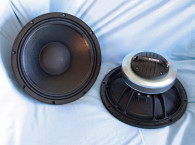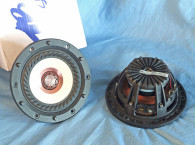

The 12CXN88 pro sound 12” coaxial driver (see Photo 1 a and b) is unique in that it uses a single neodymium magnet assembly for both the 12” woofer and the 1.3” throat exit compression driver. In terms of features, the 12CXN88 woofer is built on a proprietary 12-spoke (made up from six twin leg spokes) cast-aluminum frame with eight mounting holes. For cooling, there are six 5 mm × 45 mm vents between the back of the frame and the motor front plate that create an open area below the spider mounting shelf and provide an air path across the front plate and the voice coil.
Attached to the frame is the woofer’s neodymium ring magnet motor structure with the compression driver finned assembly that shares the same magnet with the woofer attached to the back-shaped plate and firing into what would normally be a pole vent. Attached to the top of the pole piece is a short 80 mm diameter 80° conical aluminum horn that completes the compression driver. This is covered and concealed by a 4.5” diameter breathable dust cap. Visible motor parts for the compression driver include the shaped rear cast aluminum diaphragm cover with 14 heatsink fins. As with most B&C Speakers compression drivers, the diaphragm is field replaceable with color-coded push terminals.
The 12CXN88 woofer cone assembly includes a curvilinear front coated paper cone suspended by a coated cloth M-shaped surround. Coupling the cone to the driver motor is an 88 mm (3.5”) diameter voice coil wound with aluminum wire on a nonconducting former terminated to a color-coded push button terminal block. Other features for the woofer include an aluminum shorting ring and a double silicone spider providing the remaining compliance for the cone assembly.
For the high-frequency compression driver, B&C Speakers incorporates a titanium diaphragm coupled to a 75 mm (3”) voice coil wound with aluminum wire. Sensitivity for this compression driver is rated at 106 dB and the device has a minimum recommended crossover frequency of 1.2 kHz with a second-order slope or greater.



Testing commenced with the woofer half of this coaxial driver. I used the LinearX LMS and VIBox to produce both voltage and admittance (current) curves with the driver clamped to a rigid test fixture in free air at 0.3V, 1V, 3V, 6V, 10V, 15V, 20V and 30V. Note that the LMS oscillator is turned on for a progressively increasing time period between sweeps in order to keep the driver heated as close to the third thermal time constant as possible (from 10 to 30 seconds between sweeps, depending on the voltage level).
Following the established Test Bench test protocol, I no longer use a single added mass measurement and instead used actual measured cone assembly weight provided by B&C Speakers. The 12CXN88 woofer motor stayed very linear throughout the test sequence and none of the curves were discarded. In fact, if my ears could stand being in the test room, it probably would have produced usable data at 40V. Next, I post-processed the 16 550-point stepped sine wave sweeps for each sample and divided the voltage curves by the current curves to derive impedance curves, phase calculated. I imported them, along with the accompanying voltage curves, to the LEAP 5 Enclosure Shop software.
Because most Thiele-Small (T-S) parameter data provided by OEM manufacturers is produced using either a standard model or the LEAP 4 TSL model, I additionally created a LEAP 4 TSL model using the 1 V free-air curves. I selected the complete data set, the multiple voltage impedance curves for the LTD model and the 1 V impedance curves for the TSL model in LEAP 5’s transducer derivation menu and created the parameters for the computer box simulations.
Figure 1 shows the woofer 1 V free-air impedance curve. Figure 2 shows the compression driver impedance curve. Table 1 compares the LEAP 5 LTD and TSL data and factory parameters for both B&C 12CXN88 samples. Parameter measurement results for the 12CX76 certainly showed some variation, with the factory looking more damped. I compared the LEAP 5 box simulations with both the factory data and the Sample 1 data, and while there was a 1 dB peak at the knee of the factory data rolloff, the F3 was nearly identical, so it’s fairly close. Also note that the B&C Speakers uses an Xmax calculation that deviates from the standard one that I used in Test Bench ((Gap Height - Voice Coil Length)/2) and includes a portion of the gap fringe field, resulting in a larger Xmax number.



Given that, I proceeded to set up two computer enclosure simulations using the LEAP LTD parameters for Sample 1. This included two vented alignments, neither of which fit classic alignment functions such as QB3 or EBS (the enclosures were too small to be practical). So, I basically used larger enclosures that produced a typically damped response (reasonable group delay) and a useable F3. This resulted in a 1 ft3 box, vented 1, with 15% fiberglass fill material tuned to 70 Hz, and a 1.5 ft3 box, vented 2, tuned to 60 Hz, also with 15% fiberglass fill material.
Figure 3 shows the results for the 12CXN88 woofer in the two vented boxes at 2.83 V and at a voltage level high enough to increase cone excursion to Xmax + 15% (6 mm for the 12CXN88). This produced a F3 frequency of 68 Hz (-6 dB = 61 Hz) for the 1 ft3 box tuned to 70 Hz and -3 dB = 54 Hz (-6 dB = 50 Hz) for the 1.5 ft3 box vented simulation tuned to 60 Hz.
Increasing the voltage input to the simulations until reaching the maximum linear cone excursion (Xmax + 15%) resulted in 116.5 dB at 30 V for the 1 ft3 enclosure simulation and in 115 dB at the same 30 V input for the 1.5 ft3 vented box. Figure 4 shows the 2.83 V group delay curves. Figure 5 shows the 30 V excursion curves. Looking at the excursion curves shown in Figure 4, like any vented speaker, the B&C Speakers 12CNX88 would play louder with less distortion if a fourth-order high-pass filter were incorporated, probably at about 35 Hz.





Klippel analysis for the B&C Speakers 12CXN88 produced the Bl(X), Kms(X), and Bl and Kms symmetry range plots given in Figures 6–9. Our analyzer is provided courtesy of Klippel GmbH. Analysis was performed by Patrick Turnmire, of Redrock Acoustics. This data is valuable for transducer engineering, so if you don’t own a Klippel analyzer and would like to have analysis done on a particular driver project, visit www.redrockacoustics.com.
The Bl(X) curve for the 12CXN88 woofer is moderately broad and relatively symmetrical with some coil-out offset (see Figure 6). Looking at the Bl symmetry plot (see Figure 7), the 12CXN88 has a relatively small 0.92 mm rearward (coil-out) at the driver’s physical Xmax, suggesting that this driver is just slightly out from magnetic center, but probably within QC tolerance.
Figure 8 and Figure 9 depict the Kms(X) and Kms symmetry range curves. The Kms(X) curve is quite symmetrical in both directions, with an extremely small amount of coil-in (rearward) offset. Looking at the Kms symmetry curve, the offset a negligible 0.16 mm at the physical Xmax, and is more or less constant throughout its operating range.
Displacement limiting numbers calculated by the Klippel analyzer were XBl at 82% (Bl decreasing to 82% of its maximum value) was 5.4 mm and for crossover (XC) at 75% (compliance decreasing to 75% of its maximum value) was 5.1 mm, which means that for the 12CXN88, the compliance is the most limiting factor at the prescribed distortion level of 10%. Ten percent may be somewhat conservative given the relative difficulty of perceiving total harmonic distortion (THD) subjectively, so if we apply the 20% distortion criteria with Bl decreasing to 70% and compliance decreasing to 50%, then the numbers are XBl = 7.1 mm and XC = 7.7 mm, both numbers beyond the physical 5.25 mm Xmax of the 12CXN88.
Figure 10 gives the inductance curve L(X) for the 12CXN88woofer. Inductance will typically increase in the rear direction from the zero rest position as the voice coil covers more pole area unless the driver incorporates a shorting ring. Since the 12CXN88 incorporates a faraday shield (shorting ring) in the motor assemble, we see the inductance decrease for the coil-in direction of motion. This inductive change is not great and from Xmax in to Xmax out, and only varies between 0.58 mH to 0.73 mH.






In this article I will inaugurate the permanent inclusion of the LOUDSOFT FINE R+D analyzer as part of our Test Bench testing. This means that Test Bench explications now include data from LinearX LMS, LOUDSOFT FINE R+D, the G.R.A.S. 46BE 0.25” measurement microphone, the Klippel distortion analyzer, Listen, Inc. Audio Connect using SoundCheck 15.0, and the Audiomatica’s CLIO analyzer.
I mounted the 12CXN88 in an enclosure with a 15” × 16” baffle and was filled with damping material (foam). Then, I measured both the woofer and the compression driver/horn on- and off-axis frequency response from 300 Hz to 40 kHz at 2.83 V/1 m using the FINE R+D analyzer and the G.R.A.S. 46BE 0.25” microphone (courtesy of LOUDSOFT and G.R.A.S.) for both the woofer and the compression driver/horn.
Figure 11 provides the 12CXN88 woofer’s on-axis response. Figure 12 shows the compression driver/horn combination’s on-axis response. The woofer response has a fairly smooth ±2.3 dB response out to 2.8 kHz just prior to the low-pass rolloff. For the compression driver/horn, the response is ±2.1 dB from 700 Hz to 3.5 kHz, followed by a declining response out to 20 kHz.
Figure 13 depicts the woofer’s on- and off-axis frequency response at 0°, 15°, 30°, and 45° using the FINE R+D analyzer (I normally do the SPL off-axis out to 60° for PA drivers, but these types of coax drivers are intended mostly for relatively nearfield applications, so 45° is adequate). The -3 dB at 30° with respect to the on-axis curve occurs at 1 kHz making 1 kHz to 1.4 kHz a reasonable crossover range, with B&C Speakers recommending a 1.2 kHz crossover frequency for the compression driver.
Figure 14 shows the normalized 0° to 45° accomplished using LMS. Figure 15 shows the CLIO polar plot (using 10° increments). And Figure 16 gives the two-sample SPL comparisons, using FINE R+D/G.R.A.S for the 12CXN88 woofer samples. Both samples are obviously closely matched in the operating range.




For the compression driver with the conical 80° horn, Figure 17 illustrates the on- and off-axis horizontal frequency response out to 45°. Figure 18 shows the normalized response. Figure 19 shows the CLIO polar plot. Figure 20 depicts the two-sample SPL comparison for the compression driver/horn, which is quite good throughout the entire frequency range, with some increased deviation around 2 kHz.
The last group of tests was performed using the Listen, Inc. AmpConnect analyzer and SC-1 microphone (courtesy of Listen, Inc.) and SoundCheck V15 software to measure distortion and generate time-frequency plots. Setting up for the distortion measurement consisted of mounting the driver rigidly in free-air, and setting the SPL to 104 dB at 1 m using a noise stimulus (SoundCheck has a software generator and SPL meter as two of its utilities).


I measured the distortion with the microphone placed 10 cm from the dust cap/horn mouth. This produced the distortion curves shown in Figure 21 for the woofer (7.36 V) and in Figure 22 for the compression driver (2.29 V).
Following the distortion test, I set up SoundCheck to produce a 2.83 V/1 m impulse response for both the woofer and the compression driver and imported the data into Listen’s SoundMap Time/Frequency software. Figure 23 shows the resulting cumulative spectral decay (CSD) waterfall plot for the woofer. Figure 24 shows the resulting CSD waterfall plot for the compression driver.
Last, Figure 25 gives the Wigner-Ville logarithmic surface map (which I chose for its better low-frequency performance) for the woofer. Figure 26 shows the Short-Time Fourier Transform (STFT) for the compression driver.
Overall, the 12CXN88, like the 12FCX76, is a well-executed coax driver for pro sound applications (e.g., stage monitors or studio monitors), plus it has the outstanding build quality exhibited by all of B&C Speakers’ products. For more information, contact B&C Speakers N.A., National U.S. Sales Office, 220 W. Parkway, Unit 11, Pompton Plains, NJ 07444, (973) 248-0955, Fax (973) 248-0956, e-mail Bennett Prescott, or visit www.bcspeakers.com. VC




This article was originally published in Voice Coil, January 2018.









